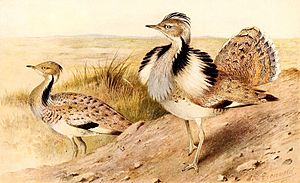MacQueen's bustard facts for kids
Quick facts for kids MacQueen's bustard |
|
|---|---|
 |
|
| Conservation status | |
| Scientific classification | |
| Genus: |
Chlamydotis
|
| Species: |
macqueenii
|
 |
|
| Range of Ch. macqueenii Breeding Resident Non-breeding Reintroduced (resident) | |
The MacQueen's bustard (Chlamydotis macqueenii) is a large, ground-dwelling bird that belongs to the bustard family. These birds are known for their unique looks and interesting behaviors. They live in dry, open areas across parts of Asia.
Sadly, the MacQueen's bustard is currently listed as a Vulnerable species. This means their numbers are decreasing, and they need our help to survive in the wild.
Contents
What Does It Look Like?
MacQueen's bustards are medium-sized birds, standing about 60 to 70 centimeters (24 to 28 inches) tall. They have long legs and a long neck. Their feathers are mostly sandy brown, which helps them blend in with their desert and steppe homes. This coloring is called camouflage.
One of their most striking features is a black and white stripe on the sides of their neck. Males have a special display during mating season. They puff up their neck feathers into a large, fluffy ruff or collar. They also raise a crest of feathers on their head. This makes them look very impressive!
Where Do They Live?
MacQueen's bustards are found across a wide area, from the Middle East to Central Asia. They live in countries like Pakistan, Mongolia, and parts of Central Asia.
They prefer dry, open habitats. This includes deserts, semi-deserts, and steppes. These areas often have sparse vegetation, like small shrubs and grasses. They are well-adapted to living in these harsh environments.
Many MacQueen's bustards are migratory birds. This means they travel long distances between their breeding grounds and their wintering areas. They usually breed in the northern parts of their range during spring and summer. Then, they fly south to warmer regions for the winter. Some populations, however, stay in the same area all year round.
What Do They Eat?
MacQueen's bustards are omnivores, meaning they eat both plants and animals. Their diet depends on what is available in their habitat.
They often forage for insects, especially beetles, grasshoppers, and caterpillars. They also eat small lizards, snakes, and even tiny rodents. For plant matter, they consume seeds, berries, and young shoots. Their varied diet helps them survive in different seasons and locations.
Life Cycle and Reproduction
The breeding season for MacQueen's bustards usually begins in spring. Males perform elaborate courtship displays to attract females. They puff up their neck feathers, raise their crests, and run around in circles. They also make special calls.
After mating, the female lays her eggs directly on the ground. She usually makes a shallow scrape in the soil, often near a bush or a clump of grass for some cover. She typically lays 2 to 4 eggs.
The female is responsible for incubating the eggs, which means keeping them warm until they hatch. She also takes care of the chicks once they are born. The young bustards grow quickly and soon learn to find food on their own.
Why Are They Vulnerable?
The MacQueen's bustard is facing several threats that have led to its Vulnerable status.
One major threat is habitat loss. Their natural homes are being destroyed or changed by human activities. This includes farming, building new towns, and developing land for other uses. When their habitat disappears, they have fewer places to live and find food.
Another big problem is poaching, which is illegal hunting. These birds are sometimes hunted for sport or for their meat. Even though it's against the law in many places, poaching continues to be a serious issue.
Conservation efforts are underway to protect these birds. This includes creating protected areas where they can live safely. There are also programs to raise bustards in captivity and then release them into the wild. These efforts aim to help their populations recover.
Images for kids
More to Explore
- In Spanish: Hubara de MacQueen para niños




